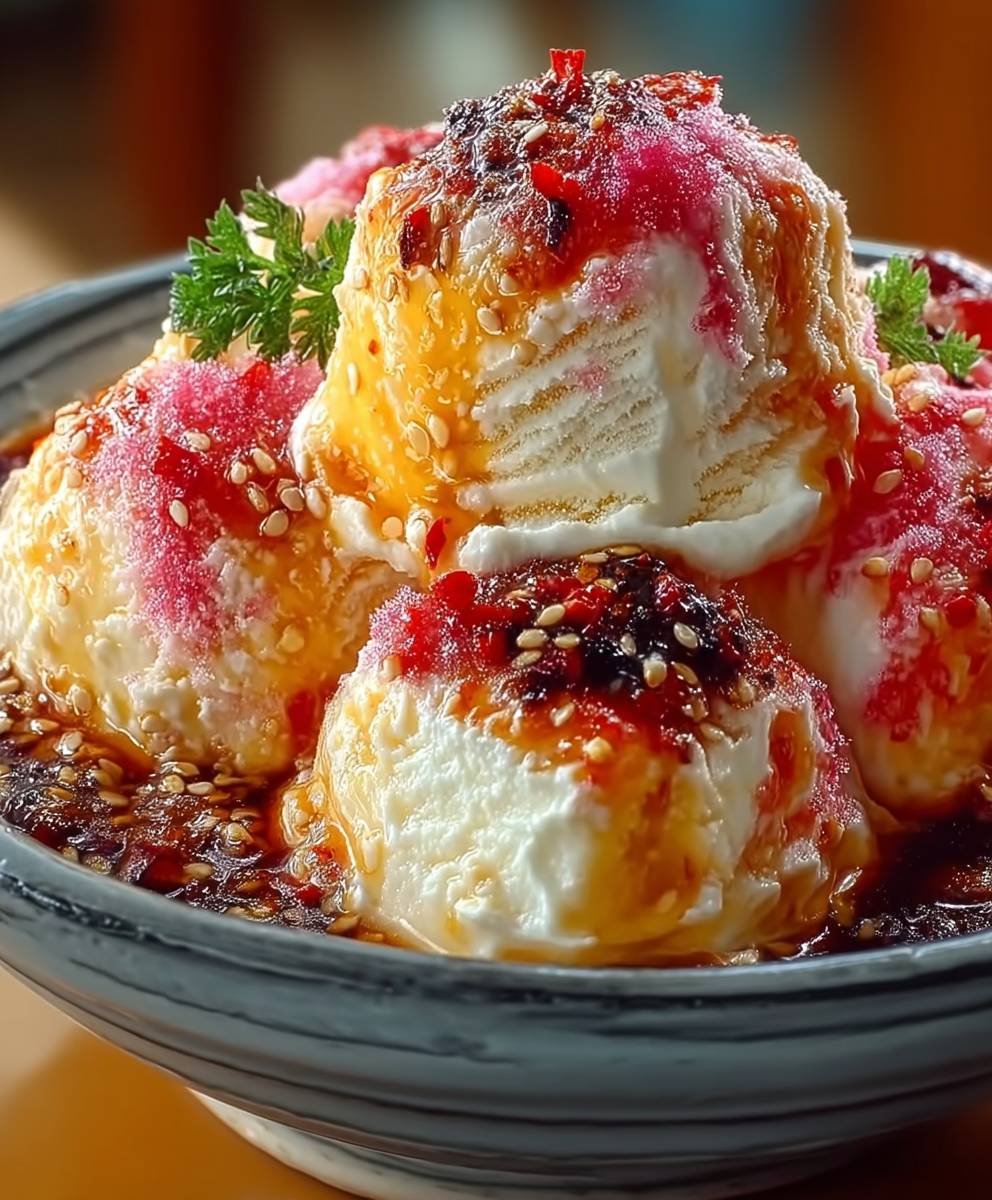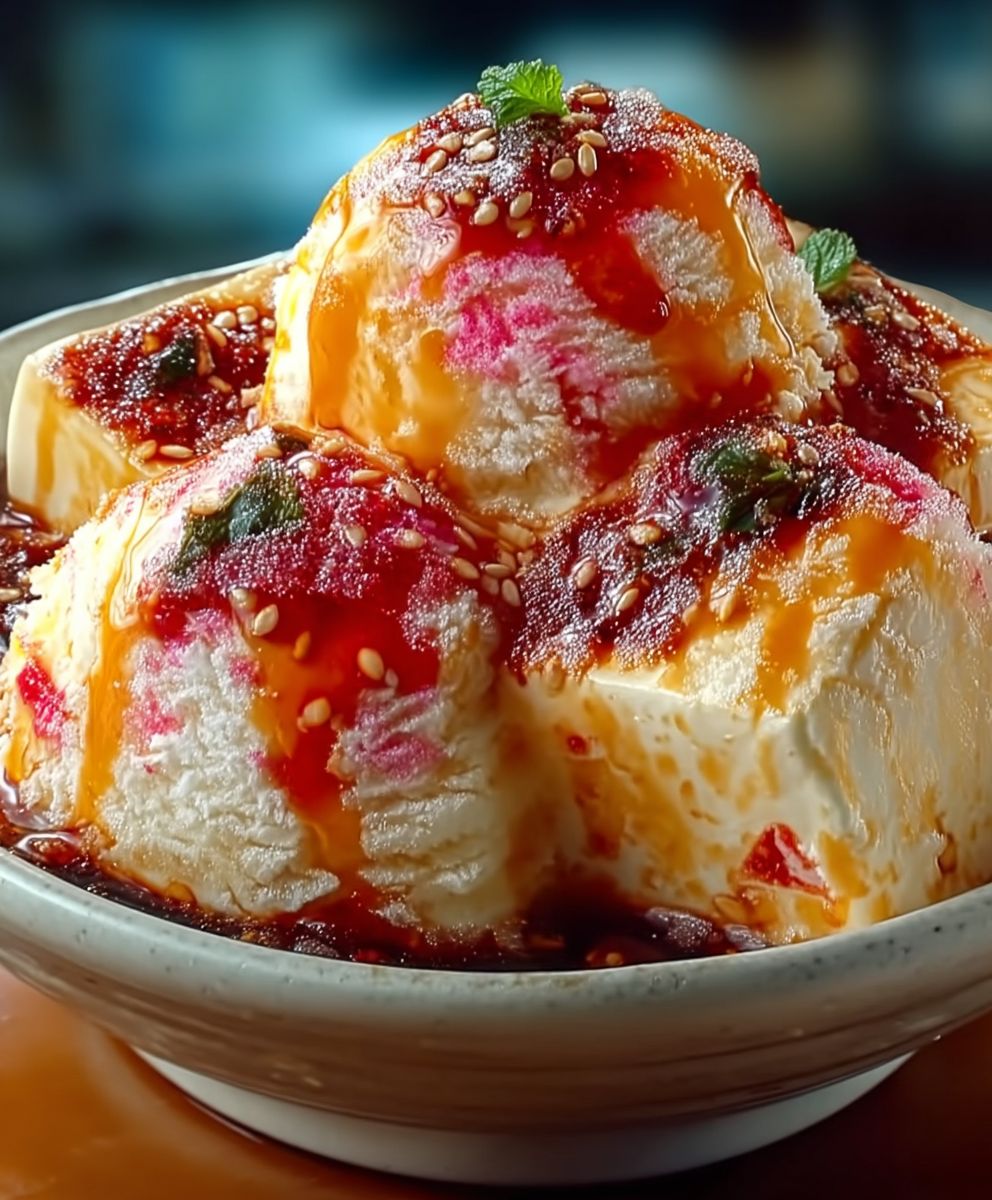Mapo Tofu Authentic: Prepare to embark on a culinary journey straight to the heart of Sichuan, China! Imagine a dish so vibrant, so intensely flavorful, that it awakens every single taste bud. This isn’t just tofu; it’s an experience. We’re talking about Mapo Tofu, and we’re not holding back on the authentic part.
Legend has it that Mapo Tofu originated in Chengdu during the Qing Dynasty, created by a woman with pockmarks (hence “Mapo,” meaning pockmarked grandma). Her humble dish, born out of necessity and resourcefulness, quickly became a local favorite. Its a testament to how simple ingredients, when combined with skill and passion, can create something truly extraordinary.
What makes Mapo Tofu Authentic so irresistible? Its the perfect balance of flavors and textures: the silky smoothness of the tofu, the savory depth of the fermented black beans, the fiery kick of chili bean paste, and the tingling sensation of Sichuan peppercorns. People adore this dish because it’s both comforting and exciting, a symphony of sensations that dance on your palate. Plus, it’s relatively quick and easy to prepare, making it a fantastic weeknight meal that will impress your family and friends. Get ready to create a truly unforgettable Mapo Tofu experience!
Ingredients:
- For the Tofu:
- 1 pound silken or soft tofu, drained and cut into 1-inch cubes
- 1 teaspoon salt
- Water for blanching
- For the Sauce:
- 2 tablespoons vegetable oil
- 2 ounces ground pork or beef (can substitute with finely chopped mushrooms for a vegetarian option)
- 2 tablespoons doubanjiang (fermented broad bean paste)
- 1 tablespoon douchi (fermented black beans), rinsed and chopped
- 1 tablespoon Sichuan peppercorns, lightly toasted and ground
- 2 cloves garlic, minced
- 1 inch ginger, minced
- 1 cup chicken or vegetable broth
- 1 tablespoon soy sauce
- 1 teaspoon sugar
- 1/2 teaspoon dark soy sauce (for color, optional)
- 1/4 teaspoon ground white pepper
- For the Slurry:
- 1 tablespoon cornstarch
- 2 tablespoons cold water
- For Garnish:
- 2 tablespoons chopped green onions
- 1 teaspoon Sichuan chili oil (optional)
- Extra ground Sichuan peppercorns (optional)
Preparing the Tofu
First things first, let’s get our tofu ready. This step is crucial because it helps the tofu hold its shape during cooking and also removes some of the excess water, allowing it to better absorb the flavorful sauce. I’ve found that blanching the tofu makes a world of difference in the final texture.
- Gently cube the tofu: Carefully remove the tofu from its packaging and drain off any excess water. Using a sharp knife, cut the tofu into roughly 1-inch cubes. Try to be gentle so you don’t break the tofu apart. Silken tofu is particularly delicate, so handle it with care.
- Blanch the tofu: Bring a pot of water to a gentle simmer. Add 1 teaspoon of salt to the water. The salt helps to season the tofu from the inside out. Gently add the tofu cubes to the simmering water.
- Cook briefly: Let the tofu simmer for about 2-3 minutes. This brief blanching is all it needs. Don’t overcook it, or it will become too soft and fall apart easily.
- Drain and set aside: Carefully remove the tofu from the pot using a slotted spoon and gently place it in a colander to drain. Set it aside while you prepare the sauce.
Making the Mapo Tofu Sauce
Now for the heart and soul of Mapo Tofu the sauce! This is where all the magic happens. The combination of doubanjiang, douchi, and Sichuan peppercorns creates that signature spicy, savory, and numbing flavor that makes this dish so addictive. Don’t be intimidated by the ingredients; each one plays a vital role in building the complex flavor profile.
- Prepare the aromatics: Mince the garlic and ginger. Make sure they are finely minced so their flavors can fully infuse the oil. Chop the douchi (fermented black beans) after rinsing them briefly under cold water to remove excess salt. Lightly toast the Sichuan peppercorns in a dry pan over medium heat for a minute or two, until fragrant. Be careful not to burn them. Grind the toasted peppercorns using a spice grinder or mortar and pestle.
- Brown the ground meat: Heat 2 tablespoons of vegetable oil in a wok or large skillet over medium-high heat. Add the ground pork or beef (or finely chopped mushrooms for a vegetarian version) and cook, breaking it up with a spatula, until browned and cooked through. This usually takes about 5-7 minutes. Remove the cooked meat from the wok and set aside.
- Sauté the aromatics and bean paste: Add the minced garlic and ginger to the wok and sauté for about 30 seconds, until fragrant. Be careful not to burn them. Add the doubanjiang (fermented broad bean paste) and douchi (fermented black beans) to the wok and sauté for another minute, stirring constantly. This step is crucial for releasing the flavors of the bean paste and black beans. The oil should turn a deep red color.
- Add the ground Sichuan peppercorns and meat: Stir in the ground Sichuan peppercorns and the cooked ground meat. Mix well to combine all the ingredients.
- Add the broth and seasonings: Pour in the chicken or vegetable broth. Add the soy sauce, sugar, dark soy sauce (if using), and ground white pepper. Bring the mixture to a simmer.
- Simmer the sauce: Reduce the heat to low and let the sauce simmer for about 5-10 minutes, allowing the flavors to meld together. This step is important for developing the depth of flavor in the sauce.
Combining Tofu and Sauce
Now comes the exciting part bringing the tofu and sauce together! This is where the dish really starts to take shape. Be gentle with the tofu as you add it to the sauce, and make sure to coat it evenly with the flavorful mixture.
- Gently add the tofu: Carefully add the blanched tofu cubes to the simmering sauce. Gently stir to coat the tofu with the sauce, being careful not to break the tofu apart.
- Simmer the tofu in the sauce: Let the tofu simmer in the sauce for about 5-7 minutes, allowing it to absorb the flavors. This step is crucial for infusing the tofu with the spicy, savory sauce.
- Thicken the sauce with the slurry: In a small bowl, whisk together the cornstarch and cold water to create a slurry. Slowly pour the slurry into the simmering sauce, stirring constantly, until the sauce thickens to your desired consistency. The slurry helps to create a glossy, rich sauce that clings to the tofu.
Serving and Garnishing
Almost there! Now it’s time to plate up your Mapo Tofu and add the finishing touches. A sprinkle of green onions and a drizzle of Sichuan chili oil (if you like it extra spicy) will elevate the dish to the next level.
- Serve immediately: Ladle the Mapo Tofu into bowls and serve immediately. It’s best enjoyed hot and fresh.
- Garnish: Garnish with chopped green onions and a drizzle of Sichuan chili oil (if desired). You can also sprinkle on some extra ground Sichuan peppercorns for an extra kick of numbing spice.
- Serve with rice: Mapo Tofu is traditionally served with steamed white rice. The rice provides a neutral base that complements the bold flavors of the dish.

Conclusion:
And there you have it! This isn’t just another tofu dish; it’s an authentic journey to the heart of Sichuan cuisine. I truly believe this Mapo Tofu Authentic recipe is a must-try for anyone who loves bold flavors, a satisfying kick of spice, and the incredible textural contrast of silky tofu and savory ground meat. It’s a dish that’s both comforting and exciting, perfect for a weeknight dinner or a weekend gathering.
Why is it a must-try? Because it delivers on the promise of authentic flavor. We’ve taken the time to source the right ingredients, like doubanjiang and Sichuan peppercorns, which are essential for achieving that signature numbing-spicy sensation known as “ma la.” This isn’t a watered-down version; it’s the real deal, adapted for the home cook. Plus, it’s surprisingly easy to make once you have your ingredients prepped. The entire process, from start to finish, takes less than 30 minutes, making it a fantastic option when you’re short on time but craving something truly special.
But the best part? It’s incredibly versatile! While I’ve presented the classic version, feel free to experiment and make it your own.
Serving Suggestions and Variations
* Rice is a Must: Traditionally, Mapo Tofu is served over a bed of fluffy white rice. The rice acts as a blank canvas, soaking up all that delicious sauce and providing a welcome contrast to the intense flavors. Jasmine rice or short-grain rice are excellent choices.
* Spice Level Adjustment: Not a fan of intense heat? No problem! You can easily adjust the amount of chili bean paste (doubanjiang) and chili oil to suit your preference. Start with a smaller amount and taste as you go. Remember, you can always add more, but you can’t take it away!
* Meat Alternatives: While ground beef or pork are traditional, you can easily substitute with ground turkey, chicken, or even a plant-based ground meat alternative for a vegetarian or vegan version. Just be sure to adjust the cooking time accordingly.
* Tofu Types: I recommend using firm or extra-firm tofu for this recipe, as it holds its shape better during cooking. However, if you prefer a softer texture, you can use silken tofu, but be extra gentle when handling it to prevent it from breaking apart.
* Vegetable Additions: Feel free to add other vegetables to the dish, such as diced bell peppers, mushrooms, or water chestnuts, for added texture and flavor.
* Garnish Galore: Don’t forget the garnishes! A sprinkle of chopped scallions, cilantro, and toasted sesame seeds adds a pop of freshness and visual appeal.
I’m so excited for you to try this recipe and experience the magic of authentic Mapo Tofu for yourself. It’s a dish that’s sure to impress your family and friends, and it’s a great way to expand your culinary horizons.
So, what are you waiting for? Gather your ingredients, put on your apron, and get cooking! And most importantly, don’t forget to share your experience with me. I’d love to hear how it turned out, what variations you tried, and any tips or tricks you discovered along the way. Leave a comment below, tag me on social media, or send me an email. I can’t wait to see your creations! Happy cooking!
Mapo Tofu Authentic: The Ultimate Guide to Making It at Home
Spicy and savory Mapo Tofu with silken tofu in a rich, flavorful sauce made with doubanjiang, douchi, and Sichuan peppercorns. A classic Sichuan dish that's both comforting and exciting.
Ingredients
- 1 pound silken or soft tofu, drained and cut into 1-inch cubes
- 1 teaspoon salt
- Water for blanching
- 2 tablespoons vegetable oil
- 2 ounces ground pork or beef (can substitute with finely chopped mushrooms for a vegetarian option)
- 2 tablespoons doubanjiang (fermented broad bean paste)
- 1 tablespoon douchi (fermented black beans), rinsed and chopped
- 1 tablespoon Sichuan peppercorns, lightly toasted and ground
- 2 cloves garlic, minced
- 1 inch ginger, minced
- 1 cup chicken or vegetable broth
- 1 tablespoon soy sauce
- 1 teaspoon sugar
- 1/2 teaspoon dark soy sauce (for color, optional)
- 1/4 teaspoon ground white pepper
- 1 tablespoon cornstarch
- 2 tablespoons cold water
- 2 tablespoons chopped green onions
- 1 teaspoon Sichuan chili oil (optional)
- Extra ground Sichuan peppercorns (optional)
Instructions
- Gently cube the tofu: Carefully remove the tofu from its packaging and drain off any excess water. Using a sharp knife, cut the tofu into roughly 1-inch cubes. Try to be gentle so you don’t break the tofu apart. Silken tofu is particularly delicate, so handle it with care.
- Blanch the tofu: Bring a pot of water to a gentle simmer. Add 1 teaspoon of salt to the water. The salt helps to season the tofu from the inside out. Gently add the tofu cubes to the simmering water.
- Cook briefly: Let the tofu simmer for about 2-3 minutes. This brief blanching is all it needs. Don’t overcook it, or it will become too soft and fall apart easily.
- Drain and set aside: Carefully remove the tofu from the pot using a slotted spoon and gently place it in a colander to drain. Set it aside while you prepare the sauce.
- Prepare the aromatics: Mince the garlic and ginger. Make sure they are finely minced so their flavors can fully infuse the oil. Chop the douchi (fermented black beans) after rinsing them briefly under cold water to remove excess salt. Lightly toast the Sichuan peppercorns in a dry pan over medium heat for a minute or two, until fragrant. Be careful not to burn them. Grind the toasted peppercorns using a spice grinder or mortar and pestle.
- Brown the ground meat: Heat 2 tablespoons of vegetable oil in a wok or large skillet over medium-high heat. Add the ground pork or beef (or finely chopped mushrooms for a vegetarian version) and cook, breaking it up with a spatula, until browned and cooked through. This usually takes about 5-7 minutes. Remove the cooked meat from the wok and set aside.
- Sauté the aromatics and bean paste: Add the minced garlic and ginger to the wok and sauté for about 30 seconds, until fragrant. Be careful not to burn them. Add the doubanjiang (fermented broad bean paste) and douchi (fermented black beans) to the wok and sauté for another minute, stirring constantly. This step is crucial for releasing the flavors of the bean paste and black beans. The oil should turn a deep red color.
- Add the ground Sichuan peppercorns and meat: Stir in the ground Sichuan peppercorns and the cooked ground meat. Mix well to combine all the ingredients.
- Add the broth and seasonings: Pour in the chicken or vegetable broth. Add the soy sauce, sugar, dark soy sauce (if using), and ground white pepper. Bring the mixture to a simmer.
- Simmer the sauce: Reduce the heat to low and let the sauce simmer for about 5-10 minutes, allowing the flavors to meld together. This step is important for developing the depth of flavor in the sauce.
- Gently add the tofu: Carefully add the blanched tofu cubes to the simmering sauce. Gently stir to coat the tofu with the sauce, being careful not to break the tofu apart.
- Simmer the tofu in the sauce: Let the tofu simmer in the sauce for about 5-7 minutes, allowing it to absorb the flavors. This step is crucial for infusing the tofu with the spicy, savory sauce.
- Thicken the sauce with the slurry: In a small bowl, whisk together the cornstarch and cold water to create a slurry. Slowly pour the slurry into the simmering sauce, stirring constantly, until the sauce thickens to your desired consistency. The slurry helps to create a glossy, rich sauce that clings to the tofu.
- Serve immediately: Ladle the Mapo Tofu into bowls and serve immediately. It’s best enjoyed hot and fresh.
- Garnish: Garnish with chopped green onions and a drizzle of Sichuan chili oil (if desired). You can also sprinkle on some extra ground Sichuan peppercorns for an extra kick of numbing spice.
- Serve with rice: Mapo Tofu is traditionally served with steamed white rice. The rice provides a neutral base that complements the bold flavors of the dish.
Notes
- Silken tofu is very delicate, so handle it with care. Soft tofu is a bit firmer and easier to work with.
- Blanching the tofu helps it hold its shape and absorb the sauce better.
- Doubanjiang, douchi, and Sichuan peppercorns are essential for the authentic Mapo Tofu flavor.
- Adjust the amount of Sichuan chili oil and ground Sichuan peppercorns to your spice preference.
- For a vegetarian version, substitute the ground pork or beef with finely chopped mushrooms.






Leave a Comment